Produits
-

Raspberry Pi Foundation Câble d'affichage FPC pour Raspberry Pi 5 (300 mm)
Raspberry Pi 5 fournit deux connecteurs MIPI à quatre voies, chacun pouvant prendre en charge une caméra ou un écran. Ces connecteurs utilisent le même format FPC « mini » à 22 voies au pas de 0,5 mm que le kit de développement de module de calcul et nécessitent des câbles adaptateurs pour se connecter aux connecteurs au format « standard » à 15 voies au pas de 1 mm du Raspbery Pi actuel. produits d'appareil photo et d'affichage. Ces câbles adaptateurs mini vers standard pour caméras et écrans (notez qu'un câble de caméra ne doit pas être utilisé avec un écran, et vice versa) sont disponibles en longueurs de 200 mm, 300 mm et 500 mm.
€ 2,95
Membres identique
-
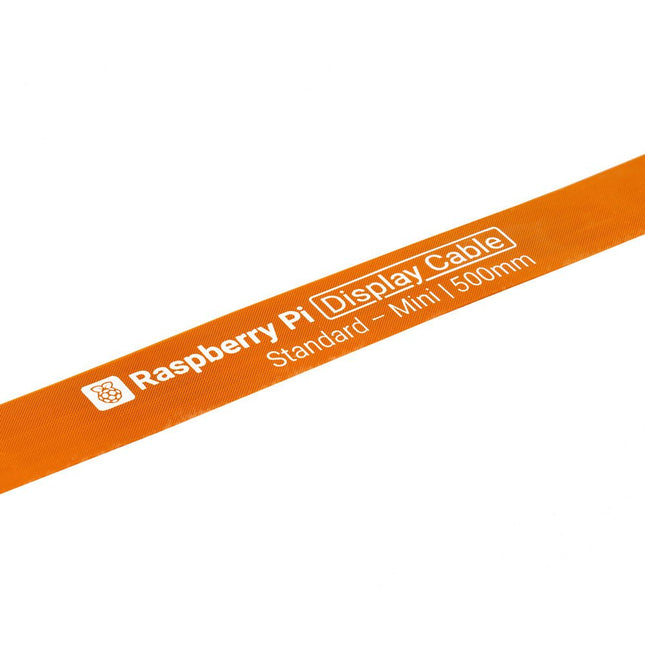
Raspberry Pi Foundation Câble d'affichage FPC pour Raspberry Pi 5 (500 mm)
Raspberry Pi 5 fournit deux connecteurs MIPI à quatre voies, chacun pouvant prendre en charge une caméra ou un écran. Ces connecteurs utilisent le même format FPC « mini » à 22 voies au pas de 0,5 mm que le kit de développement de module de calcul et nécessitent des câbles adaptateurs pour se connecter aux connecteurs au format « standard » à 15 voies au pas de 1 mm du Raspbery Pi actuel. produits d'appareil photo et d'affichage. Ces câbles adaptateurs mini vers standard pour caméras et écrans (notez qu'un câble de caméra ne doit pas être utilisé avec un écran, et vice versa) sont disponibles en longueurs de 200 mm, 300 mm et 500 mm.
€ 3,95
Membres identique
-
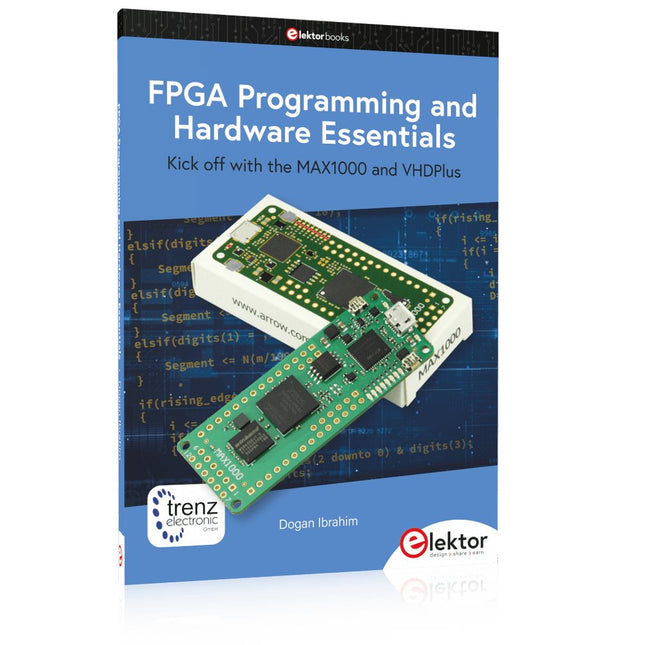
Elektor Publishing FPGA Programming and Hardware Essentials
Kick off with the MAX1000 and VHDPlus Ready to Master FPGA Programming? In this guide, we’re diving into the world of Field Programmable Gate Arrays (FPGAs) – a configurable integrated circuit that can be programmed after manufacturing. Imagine bringing your ideas to life, from simple projects to complete microcontroller systems! Meet the MAX1000: a compact and budget-friendly FPGA development board packed with features like memory, user LEDs, push-buttons, and flexible I/O ports. It’s the ideal starting point for anyone wanting to learn about FPGAs and Hardware Description Languages (HDLs). In this book, you’ll get hands-on with the VHDPlus programming language – a simpler version of VHDL. We’ll work on practical projects using the MAX1000, helping you gain the skills and confidence to unleash your creativity. Get ready for an exciting journey! You’ll explore a variety of projects that highlight the true power of FPGAs. Let’s turn your ideas into reality and embark on your FPGA adventure – your journey starts now! Exciting Projects You’ll Find in This Book Arduino-Driven BCD to 7-Segment Display Decoder Use an Arduino Uno R4 to supply BCD data to the decoder, counting from 0 to 9 with a one-second delay Multiplexed 4-Digit Event Counter Create an event counter that displays the total count on a 4-digit display, incrementing with each button press PWM Waveform with Fixed Duty Cycle Generate a PWM waveform at 1 kHz with a fixed duty cycle of 50% Ultrasonic Distance Measurement Measure distances using an ultrasonic sensor, displaying the results on a 4-digit 7-segment LED Electronic Lock Build a simple electronic lock using combinational logic gates with push buttons and an LED output Temperature Sensor Monitor ambient temperature with a TMP36 sensor and display the readings on a 7-segment LED Téléchargements Software
€ 39,95
Membres € 35,96
-

Elektor Digital FPGA Programming and Hardware Essentials (E-book)
Kick off with the MAX1000 and VHDPlus Ready to Master FPGA Programming? In this guide, we’re diving into the world of Field Programmable Gate Arrays (FPGAs) – a configurable integrated circuit that can be programmed after manufacturing. Imagine bringing your ideas to life, from simple projects to complete microcontroller systems! Meet the MAX1000: a compact and budget-friendly FPGA development board packed with features like memory, user LEDs, push-buttons, and flexible I/O ports. It’s the ideal starting point for anyone wanting to learn about FPGAs and Hardware Description Languages (HDLs). In this book, you’ll get hands-on with the VHDPlus programming language – a simpler version of VHDL. We’ll work on practical projects using the MAX1000, helping you gain the skills and confidence to unleash your creativity. Get ready for an exciting journey! You’ll explore a variety of projects that highlight the true power of FPGAs. Let’s turn your ideas into reality and embark on your FPGA adventure – your journey starts now! Exciting Projects You’ll Find in This Book Arduino-Driven BCD to 7-Segment Display Decoder Use an Arduino Uno R4 to supply BCD data to the decoder, counting from 0 to 9 with a one-second delay Multiplexed 4-Digit Event Counter Create an event counter that displays the total count on a 4-digit display, incrementing with each button press PWM Waveform with Fixed Duty Cycle Generate a PWM waveform at 1 kHz with a fixed duty cycle of 50% Ultrasonic Distance Measurement Measure distances using an ultrasonic sensor, displaying the results on a 4-digit 7-segment LED Electronic Lock Build a simple electronic lock using combinational logic gates with push buttons and an LED output Temperature Sensor Monitor ambient temperature with a TMP36 sensor and display the readings on a 7-segment LED Téléchargements Software
€ 32,95
Membres € 26,36
-
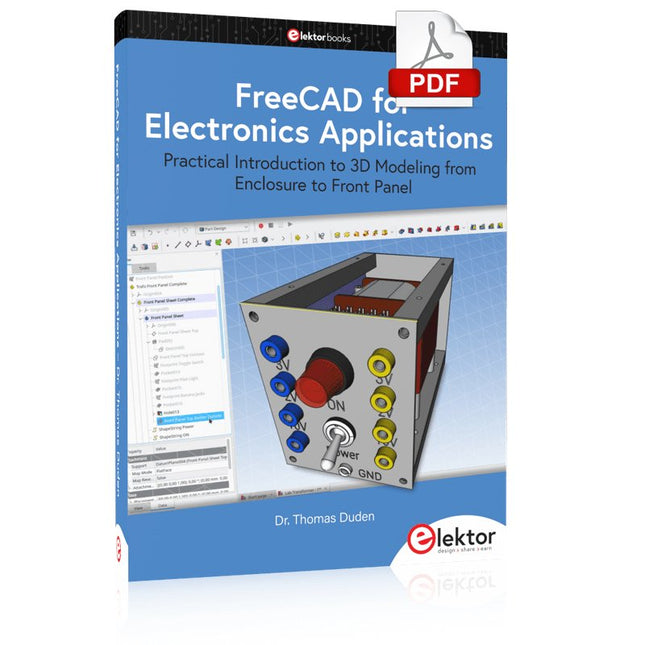
Elektor Digital FreeCAD for Electronic Applications (E-book)
Introduction pratique à la modélisation 3D du boîtier au panneau avant Intégrer un composant vintage, créer un boîtier d'aspect professionnel pour un circuit imprimé ou même concevoir un appareil complexe avec un châssis - ces défis et bien d'autres se transforment en un plaisir stimulant avec FreeCAD. Une fois que vous avez internalisé les processus de base, votre imagination n’a pratiquement aucune limite. Commencer à utiliser un nouveau logiciel n’est jamais simple – surtout avec un outil aussi polyvalent que FreeCAD. Des composants individuels gérables, mais en même temps faciles à utiliser, constituent le point de départ de ce livre. L'assemblage ultérieur de ces composants aboutit à des assemblages. Dans l'univers FreeCAD, une trajectoire réalisable est démontrée. La procédure décrite est illustrative afin que les exemples soient facilement appliqués aux tâches personnalisées. Les appareils ont été réalisés par l'auteur et illustrés de photos. Créer un design 3D demande quelques efforts, mais l’investissement initial est vite rentable. Outre la représentation spatiale impressionnante des projets, les dessins extraits constituent une base solide pour la documentation et la production. Les fonctionnalités étendues de FreeCAD, telles que le dépliage de pièces en tôle, augmentent considérablement l'efficacité et font avancer les modèles vers un assemblage pratique. Bientôt, vous ne voudrez plus vous passer de FreeCAD !
€ 34,95
Membres € 27,96
-
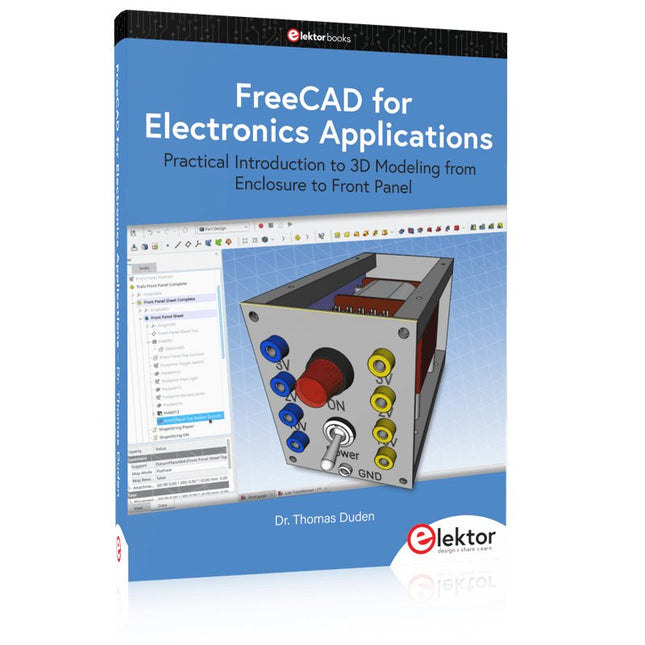
Elektor Publishing FreeCAD for Electronics Applications
Introduction pratique à la modélisation 3D du boîtier au panneau avant Intégrer un composant vintage, créer un boîtier d'aspect professionnel pour un circuit imprimé ou même concevoir un appareil complexe avec un châssis - ces défis et bien d'autres se transforment en un plaisir stimulant avec FreeCAD. Une fois que vous avez internalisé les processus de base, votre imagination n’a pratiquement aucune limite. Commencer à utiliser un nouveau logiciel n’est jamais simple – surtout avec un outil aussi polyvalent que FreeCAD. Des composants individuels gérables, mais en même temps faciles à utiliser, constituent le point de départ de ce livre. L'assemblage ultérieur de ces composants aboutit à des assemblages. Dans l'univers FreeCAD, une trajectoire réalisable est démontrée. La procédure décrite est illustrative afin que les exemples soient facilement appliqués aux tâches personnalisées. Les appareils ont été réalisés par l'auteur et illustrés de photos. Créer un design 3D demande quelques efforts, mais l’investissement initial est vite rentable. Outre la représentation spatiale impressionnante des projets, les dessins extraits constituent une base solide pour la documentation et la production. Les fonctionnalités étendues de FreeCAD, telles que le dépliage de pièces en tôle, augmentent considérablement l'efficacité et font avancer les modèles vers un assemblage pratique. Bientôt, vous ne voudrez plus vous passer de FreeCAD !
€ 44,95
Membres € 40,46
-
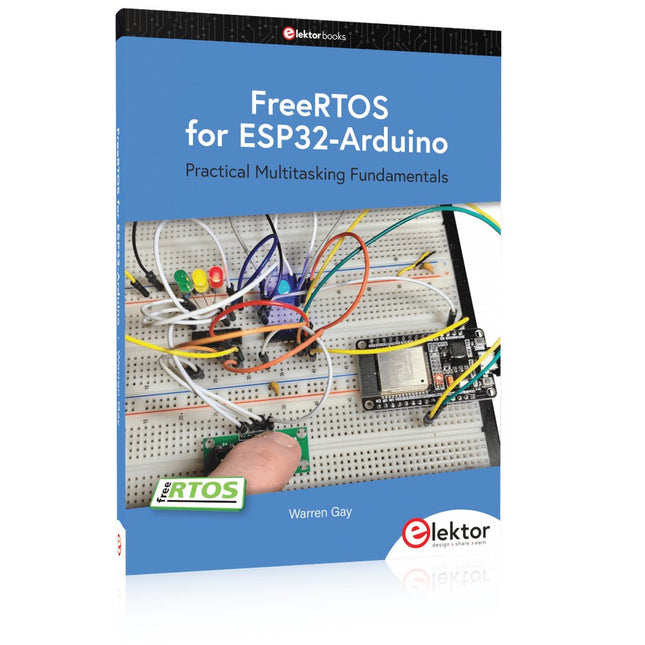
Elektor Publishing FreeRTOS for ESP32-Arduino
Practical Multitasking Fundamentals Programming embedded systems is difficult because of resource constraints and limited debugging facilities. Why develop your own Real-Time Operating System (RTOS) as well as your application when the proven FreeRTOS software is freely available? Why not start with a validated foundation? Every software developer knows that you must divide a difficult problem into smaller ones to conquer it. Using separate preemptive tasks and FreeRTOS communication mechanisms, a clean separation of functions is achieved within the entire application. This results in safe and maintainable designs. Practicing engineers and students alike can use this book and the ESP32 Arduino environment to wade into FreeRTOS concepts at a comfortable pace. The well-organized text enables you to master each concept before starting the next chapter. Practical breadboard experiments and schematics are included to bring the lessons home. Experience is the best teacher. Each chapter includes exercises to test your knowledge. The coverage of the FreeRTOS Application Programming Interface (API) is complete for the ESP32 Arduino environment. You can apply what you learn to other FreeRTOS environments, including Espressif’s ESP-IDF. The source code is available from GitHub. All of these resources put you in the driver’s seat when it is time to develop your next uber-cool ESP32 project. What you will learn: How preemptive scheduling works within FreeRTOS The Arduino startup “loopTask” Message queues FreeRTOS timers and the IDLE task The semaphore, mutex, and their differences The mailbox and its application Real-time task priorities and its effect Interrupt interaction and use with FreeRTOS Queue sets Notifying tasks with events Event groups Critical sections Task local storage The gatekeeper task
€ 44,95
Membres € 40,46
-

Elektor Digital FreeRTOS for ESP32-Arduino (E-book)
Practical Multitasking Fundamentals Programming embedded systems is difficult because of resource constraints and limited debugging facilities. Why develop your own Real-Time Operating System (RTOS) as well as your application when the proven FreeRTOS software is freely available? Why not start with a validated foundation? Every software developer knows that you must divide a difficult problem into smaller ones to conquer it. Using separate preemptive tasks and FreeRTOS communication mechanisms, a clean separation of functions is achieved within the entire application. This results in safe and maintainable designs. Practicing engineers and students alike can use this book and the ESP32 Arduino environment to wade into FreeRTOS concepts at a comfortable pace. The well-organized text enables you to master each concept before starting the next chapter. Practical breadboard experiments and schematics are included to bring the lessons home. Experience is the best teacher. Each chapter includes exercises to test your knowledge. The coverage of the FreeRTOS Application Programming Interface (API) is complete for the ESP32 Arduino environment. You can apply what you learn to other FreeRTOS environments, including Espressif’s ESP-IDF. The source code is available from GitHub. All of these resources put you in the driver’s seat when it is time to develop your next uber-cool ESP32 project. What you will learn: How preemptive scheduling works within FreeRTOS The Arduino startup “loopTask” Message queues FreeRTOS timers and the IDLE task The semaphore, mutex, and their differences The mailbox and its application Real-time task priorities and its effect Interrupt interaction and use with FreeRTOS Queue sets Notifying tasks with events Event groups Critical sections Task local storage The gatekeeper task
€ 34,95
Membres € 27,96
-

FTDI Câble USB série TTL RS232 FTDI
Ce câble série FTDI USB vers TTL (3.3 VI/O) (FTDI TTL-232R-3V3 OEM) est un appareil professionnel, de haute qualité et haute vitesse qui permet de connecter simplement et facilement des périphériques d'interface TTL à l'aide d'un port USB de rechange. Caractéristiques TTL-232R-3V3 Câble série FTDI USB vers TTL 3,3 V Câble FTDI TTL-232R-3V3 6 voies Le FTDI USB vers TTL 3,3 V est doté d'un dispositif FTDI FT232R intégré au câble Câble adaptateur FTDI USB vers TTL série 3,3 V, 6 broches, prise femelle 0,1' Puce UART IC FT232RL Compatible avec Windows 7/8/10 et Linux
€ 19,95
Membres € 17,96
-
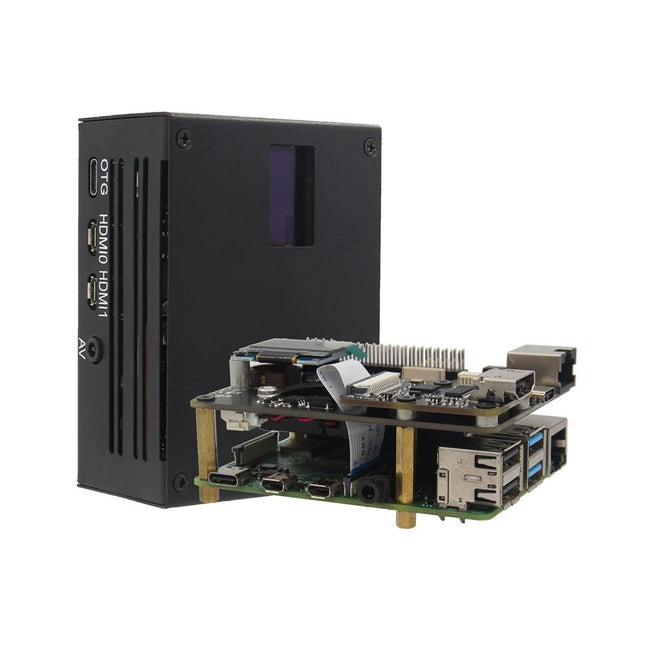
Geekworm Geekworm Kit KVM-A3 pour Raspberry Pi 4 (+ livre numérique GRATUIT)
Commandez dès maintenant le kit Geekworm KVM-A3 et recevez le livre numérique Raspberry Pi Full Stack (valeur de 35 €) gratuitement ! KVM signifie Keyboard, Video et Mouse. Il s'agit d'un puissant logiciel open source permettant l'accès à distance via Raspberry Pi. Ce kit KVM-A3 est conçu sur la base du Raspberry Pi 4. Grâce à lui, vous pouvez allumer et éteindre votre ordinateur, le redémarrer, configurer l'UEFI/BIOS et même réinstaller le système d'exploitation à l'aide d'un CD-ROM virtuel ou d'une clé USB. Vous pouvez utiliser votre propre clavier et souris distants, ou laisser KVM simuler un clavier, une souris et un écran, présentés via un navigateur web comme si vous interagissiez directement avec le système distant. Il s'agit d'un véritable accès matériel, sans dépendance aux ports, protocoles ou services distants ! Caractéristiques Spécialement conçu pour KVM (un IP-KVM DIY ouvert et abordable basé sur Raspberry Pi) Compatible avec Raspberry Pi 4 (non inclus) Entièrement compatible avec le système d'exploitation PiKVM V3 Contrôlez un serveur ou un ordinateur via un navigateur web Capture HDMI Full HD basée sur la puce TC358743 Prise en charge du clavier et de la souris OTG ; Émulation de disque dur de stockage de masse Horloge temps réel matérielle (RTC) avec emplacement pour pile bouton CR1220 Équipé d'un ventilateur pour dissiper la chaleur du Raspberry Pi Dispose de relais statiques pour protéger les broches GPIO du Raspberry Pi des décharges électrostatiques et des décharges électrostatiques Contrôle ATX via un connecteur RJ45 : allumage et extinction de la machine, réinitialisation et surveillance à distance de l'état du disque dur et des voyants d'alimentation Connecteur SH1.0 10-broches réservé à la future prise en charge audio HDMI I²S Embase 4 broches et entretoises réservées à l'écran OLED I²C Inclus Boîtier métallique KVM-A3 pour Raspberry Pi 4 Module HDMI vers CSI-2 X630 (pour la capture vidéo) Carte d'extension X630-A3 (fournit Ethernet, refroidissement, RTC, alimentation, etc.) Carte adaptateur X630-A5 (installée dans le boîtier du PC ; connecte la carte mère de l'ordinateur au câble du panneau d'E/S du boîtier) Écran OLED 0,96 pouces (128 x 64 pixels) Câble Ethernet (norme TIA/EIA-568.B ; sert également de câble de contrôle ATX) Téléchargements Wiki PiKVM OS
€ 119,95€ 79,95
Membres identique
-
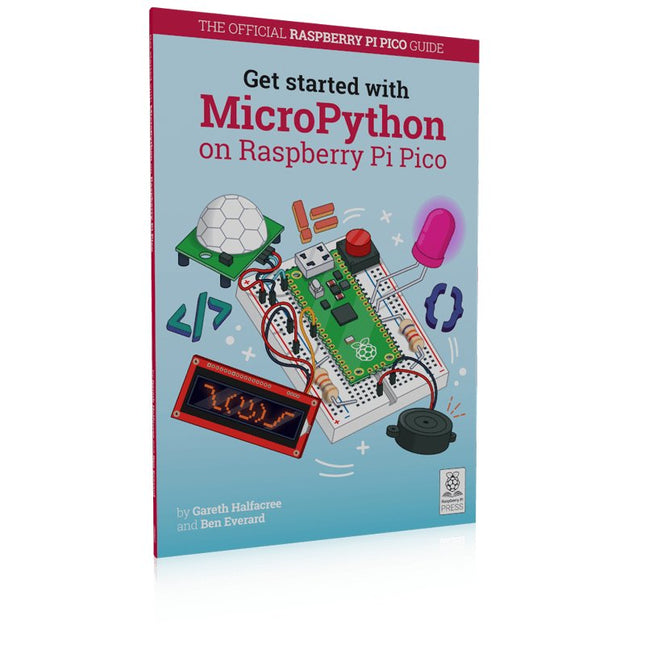
Raspberry Pi Foundation Get Started with MicroPython on Raspberry Pi Pico
In Get Started with MicroPython on Raspberry Pi Pico, you will learn how to use the beginner-friendly language MicroPython to write programs and connect up hardware to make your Raspberry Pi Pico interact with the world around it. Using these skills, you can create your own electro‑mechanical projects, whether for fun or to make your life easier. Microcontrollers, like RP2040 at the heart of Raspberry Pi Pico, are computers stripped back to their bare essentials. You don’t use monitors or keyboards, but program them to take their input from, and send their output to the input/output pins. Using these programmable connections, you can light lights, make noises, send text to screens, and much more. In Get Started with MicroPython on Raspberry Pi Pico, you will learn how to use the beginner-friendly language MicroPython to write programs and connect up hardware to make your Raspberry Pi Pico interact with the world around it. Using these skills, you can create your own electro‑mechanical projects, whether for fun or to make your life easier. The robotic future is here – you just have to build it yourself. We’ll show you how. About the authors Gareth Halfacree is a freelance technology journalist, writer, and former system administrator in the education sector. With a passion for open-source software and hardware, he was an early adopter of the Raspberry Pi platform and has written several publications on its capabilities and flexibility. Ben Everard is a geek who has stumbled into a career that lets him play with new hardware. As the editor of HackSpace magazine, he spends more time than he really should experimenting with the latest (and not-solatest) DIY tech.
€ 19,95
Membres € 17,96
-

Elektor Bundles Get Started with the NXP FRDM-MCXN947 Development Board (offre groupée)
Cette offre groupée contient : Livre : Get Started with the NXP FRDM-MCXN947 Development Board (prix normal : 40 €) NXP FRDM-MCXN947 Development Board (prix normal : 30 €) Livre : Get Started with the NXP FRDM-MCXN947 Development Board Développer des projets sur la connectivité, le graphisme, l'apprentissage automatique, le contrôle moteur et les capteurs Ce livre (en anglais) traite de l'utilisation de la carte de développement FRDM-MCXN947, développée par NXP Semiconductors. Elle intègre le double processeur Arm Cortex-M33, fonctionnant à une fréquence allant jusqu'à 150 MHz. Idéale pour les applications industrielles, IoT et d'apprentissage automatique, elle dispose d'un port USB à haute vitesse, de CAN 2.0, de l'I³C et d'Ethernet 10/100. La carte comprend un débogueur MCU-Link intégré, un FlexI/O pour le contrôle des écrans LCD, et une mémoire flash à double banque pour les opérations de lecture-écriture simultanées, prenant en charge des configurations de mémoire externe de grande capacité. L'une des caractéristiques importantes de la carte de développement est l'intégration de l'unité de traitement neuronal (NPU) eIQ Neutron, permettant aux utilisateurs de développer des projets basés sur l'intelligence artificielle. La carte de développement prend également en charge les broches de connecteur au format Arduino Uno, la rendant compatible avec de nombreux shields Arduino, ainsi qu'un connecteur mikroBUS pour les cartes Click de MikroElektronika et un connecteur Pmod. L'un des avantages intéressants de la carte de développement FRDM-MCXN947 est qu'elle inclut plusieurs sondes de débogage intégrées, permettant aux programmeurs de déboguer leurs programmes en communiquant directement avec le microcontrôleur (MCU). Grâce au débogueur, les programmeurs peuvent exécuter un programme pas à pas, insérer des points d'arrêt, visualiser et modifier des variables, etc. De nombreux projets fonctionnels et testés ont été développés dans le livre en utilisant l'IDE populaire MCUXpresso et le SDK avec divers capteurs et actionneurs. L'utilisation de la bibliothèque CMSIS-DSP populaire est également expliquée avec plusieurs opérations matricielles couramment utilisées. Les projets fournis dans le livre peuvent être utilisés sans modification dans de nombreuses applications. Alternativement, les lecteurs peuvent s'inspirer de ces projets pour développer leurs propres projets. Carte de développement NXP FRDM-MCXN947 La FRDM-MCXN947 est une carte de développement compacte et polyvalente conçue pour le prototypage rapide avec les microcontrôleurs MCX N94 et N54. Elle dispose de connecteurs standard pour un accès facile aux E/S du MCU, d'interfaces série ouvertes intégrées, d'une mémoire flash externe et d'un débogueur MCU-Link embarqué. Spécifications Microcontrôleur Cœurs MCX-N947 Dual Arm Cortex-M33 à 150 MHz chacun avec une efficacité de performance optimisée, jusqu'à 2 Mo de mémoire flash double banque avec RAM2 ECC complète en option, flash externe Accélérateurs : unité de traitement neuronal, PowerQuad, Smart2 DMA, etc. Extension de mémoire *Prise pour carte microSD DNP Connectivité Phy Ethernet et connecteur Connecteurs HS USB-C Connecteur SPI/I²C/UART (PMOD/mikroBUS, DNP) Connecteur WiFi (PMOD/mikroBUS, DNP) Émetteur-récepteur CAN-FD Débogage Débogueur MCU-Link intégré avec CMSIS-DAP Connecteur JTAG/SWD Capteur Capteur de température P3T1755 I³C/I²C, pavé tactile Options d'extension En-tête Arduino (avec lignes d'extension FRDM) En-tête FRDM En-tête FlexIO/LCD En-tête SmartDMA/Caméra Pmod *DNP microBUS Interface utilisateur DEL utilisateur RVB, plus boutons de réinitialisation, de FAI et de réveil Inclus 1x Carte de développement FRDM-MCXN947 1x Câble USB-C 1x Quick Start Guide Downloads Datasheet Block diagram
€ 69,95€ 29,95
Membres identique
-

Elektor Publishing Get Started with the Raspberry Pi AI Kit
A Beginner's Guide to AI and Edge Computing Artificial Intelligence (AI) is now part of our daily lives. With companies developing low-cost AI-powered hardware into their products, it is now becoming a reality to purchase AI accelerator hardware at comparatively very low costs. One such hardware accelerator is the Hailo module which is fully compatible with the Raspberry Pi 5. The Raspberry Pi AI Kit is a cleverly designed hardware as it bundles an M.2-based Hailo-8L accelerator with the Raspberry Pi M.2 HAT+ to offer high speed inferencing on the Raspberry Pi 5. Using the Raspberry Pi AI Kit, you can build complex AI-based vision applications, running in real-time, such as object detection, pose estimation, instance segmentation, home automation, security, robotics, and many more neural network-based applications. This book is an introduction to the Raspberry Pi AI Kit, and it is aimed to provide some help to readers who are new to the kit and wanting to run some simple AI-based visual models on their Raspberry Pi 5 computers. The book is not meant to cover the detailed process of model creation and compilation, which is done on an Ubuntu computer with massive disk space and 32 GB memory. Examples of pre-trained and custom object detection are given in the book. Two fully tested and working projects are given in the book. The first project explains how a person can be detected and how an LED can be activated after the detection, and how the detection can be acknowledged by pressing an external button. The second project illustrates how a person can be detected, and how this information can be passed to a smart phone over a Wi-Fi link, as well as how the detection can be acknowledged by sending a message from the smartphone to your Raspberry Pi 5.
€ 34,95
Membres € 31,46
-
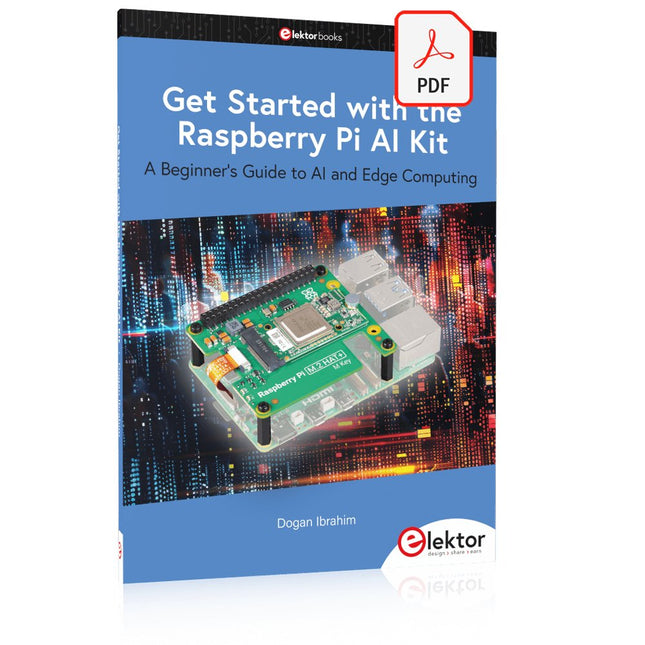
Elektor Digital Get Started with the Raspberry Pi AI Kit (E-book)
A Beginner's Guide to AI and Edge Computing Artificial Intelligence (AI) is now part of our daily lives. With companies developing low-cost AI-powered hardware into their products, it is now becoming a reality to purchase AI accelerator hardware at comparatively very low costs. One such hardware accelerator is the Hailo module which is fully compatible with the Raspberry Pi 5. The Raspberry Pi AI Kit is a cleverly designed hardware as it bundles an M.2-based Hailo-8L accelerator with the Raspberry Pi M.2 HAT+ to offer high speed inferencing on the Raspberry Pi 5. Using the Raspberry Pi AI Kit, you can build complex AI-based vision applications, running in real-time, such as object detection, pose estimation, instance segmentation, home automation, security, robotics, and many more neural network-based applications. This book is an introduction to the Raspberry Pi AI Kit, and it is aimed to provide some help to readers who are new to the kit and wanting to run some simple AI-based visual models on their Raspberry Pi 5 computers. The book is not meant to cover the detailed process of model creation and compilation, which is done on an Ubuntu computer with massive disk space and 32 GB memory. Examples of pre-trained and custom object detection are given in the book. Two fully tested and working projects are given in the book. The first project explains how a person can be detected and how an LED can be activated after the detection, and how the detection can be acknowledged by pressing an external button. The second project illustrates how a person can be detected, and how this information can be passed to a smart phone over a Wi-Fi link, as well as how the detection can be acknowledged by sending a message from the smartphone to your Raspberry Pi 5.
€ 29,95
Membres € 23,96
-

Make Getting Started with 3D Carving
Learn the basics of designing and making things with Inventables' software (Easel) and 3D carving machines (X-Carve and Carvey) This book was written for people who have never carved before. It teaches the basics of designing and making things with Inventables' software (Easel) and 3D carving machines (X-Carve and Carvey). It showcases five step-by-step projects you can build yourself as a beginner, including an inspiration tile, kitchen cutting board, custom block stamp, fidget spinner, and balsa wood glider. The book also features a gallery of aspirational projects, like an electric guitar and a box joint toolbox, to show what else is possible through 3D carving. The design files and instructions for these more complex projects can be found on the Inventables website. Projects Included Participate in the world's largest mosaic tile wall Build a glider to your own specifications Create your own inlay cutting boards Carve a fidget spinner toy Craft wooden 3D stamps you can use to create your own greeting cards
€ 22,95
Membres € 20,66
-
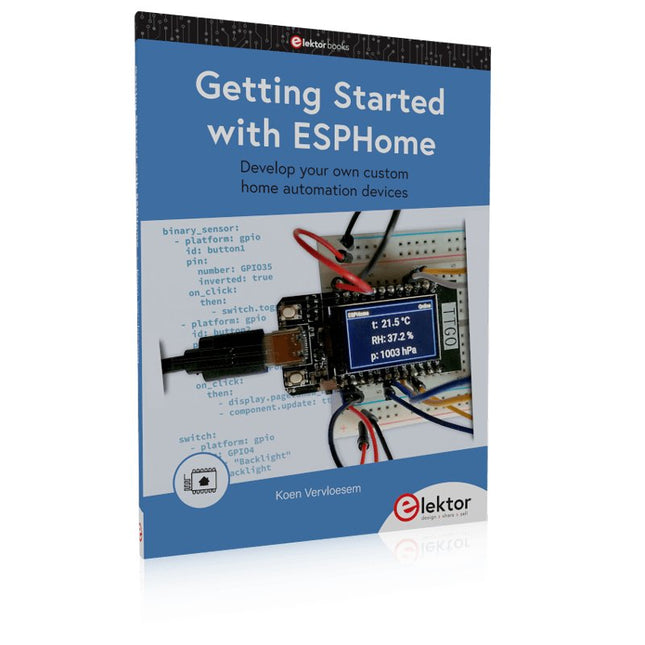
Elektor Publishing Getting Started with ESPHome
Develop your own custom home automation devices Espressif's ESP8266 and ESP32 microcontrollers have brought DIY home automation to the masses. However, not everyone is fluent in programming these microcontrollers with Espressif's C/C++ SDK, the Arduino core, or MicroPython. This is where ESPHome comes into its own: with this project, you don’t program your microcontroller but configure it. This book demonstrates how to create your own home automation devices with ESPHome on an ESP32 microcontroller board. You’ll learn how to combine all kinds of electronic components and automate complex behaviours. Your devices can work completely autonomously, and connect over Wi-Fi to your home automation gateways such as Home Assistant or MQTT broker. By the end of this book, you will be able to create your own custom home automation devices the way you want. Thanks to ESPHome and the ESP32, this is within everyone’s grasp. Set up an ESPHome development environment and create maintainable configurations Use buttons and LEDs Sound a buzzer and play melodies Read measurements from various types of sensors Communicate over a short distance with NFC, infrared light, and Bluetooth Low Energy Show information on various types of displays Downloads Software
€ 34,95
Membres € 31,46
-
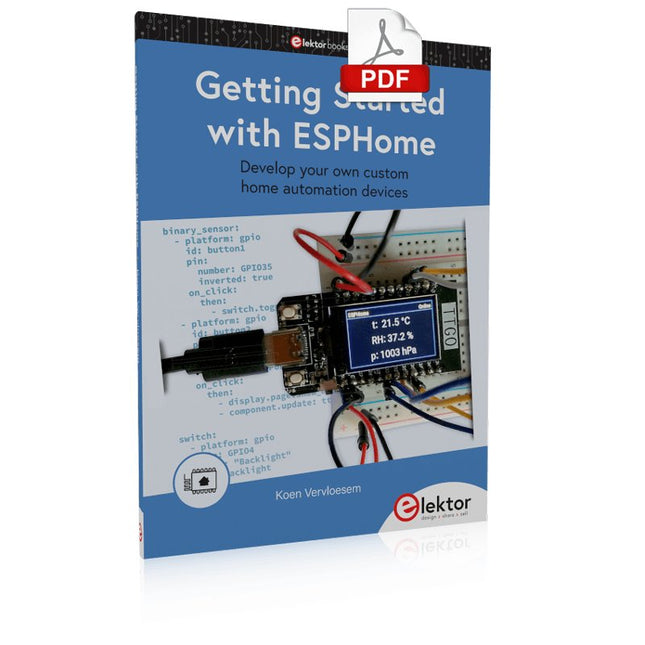
Elektor Digital Getting Started with ESPHome (E-book)
Develop your own custom home automation devices Espressif's ESP8266 and ESP32 microcontrollers have brought DIY home automation to the masses. However, not everyone is fluent in programming these microcontrollers with Espressif's C/C++ SDK, the Arduino core, or MicroPython. This is where ESPHome comes into its own: with this project, you don’t program your microcontroller but configure it. This book demonstrates how to create your own home automation devices with ESPHome on an ESP32 microcontroller board. You’ll learn how to combine all kinds of electronic components and automate complex behaviours. Your devices can work completely autonomously, and connect over Wi-Fi to your home automation gateways such as Home Assistant or MQTT broker. By the end of this book, you will be able to create your own custom home automation devices the way you want. Thanks to ESPHome and the ESP32, this is within everyone’s grasp. Set up an ESPHome development environment and create maintainable configurations Use buttons and LEDs Sound a buzzer and play melodies Read measurements from various types of sensors Communicate over a short distance with NFC, infrared light, and Bluetooth Low Energy Show information on various types of displays Downloads Software
€ 29,95
Membres € 23,96
-
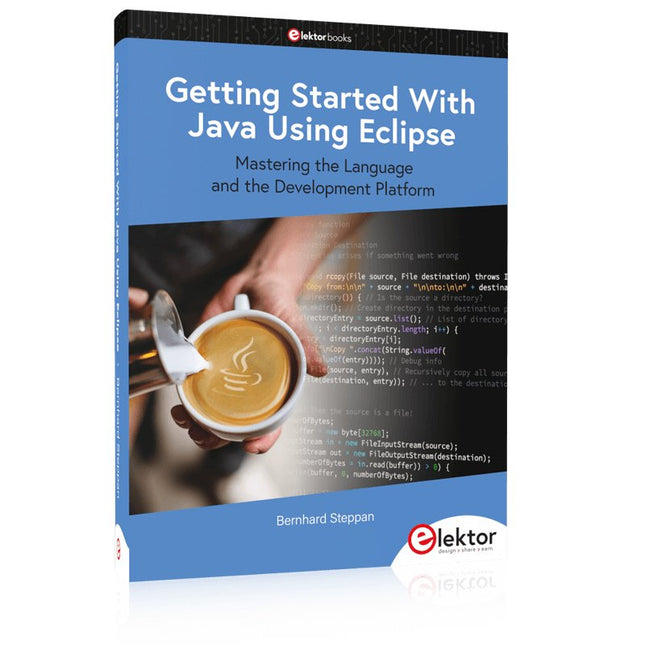
Elektor Publishing Getting Started With Java Using Eclipse
Maîtriser le langage et la plateforme de développement Beaucoup de gens aimeraient apprendre Java mais se lancer n'est pas facile puisque programmer avec Java nécessite au moins deux choses : maîtriser le langage de programmation et l'environnement de développement. A l'aide de nombreux exemples, ce livre montre comment le langage est structuré. De plus, il utilise l'environnement de développement Eclipse comme exemple d'outil puissant pour enseigner le développement de programmes Java. Dans Basics, la première partie du livre, vous acquérez vos connaissances de base sur Java et Eclipse. Cette partie pose les bases de la programmation, vous donne un aperçu de la technologie Java et vous montre les particularités de la programmation orientée objet. Dans la deuxième partie intitulée Java Language, tout tourne autour des subtilités du langage Java et c'est là que sont créées les premières petites applications Java, aidées par un savant mélange de partie connaissances et d'exercices pratiques. La technologie Java est à la fois le nom et le thème de la troisième partie qui vous présente également les règles à respecter lors de la programmation, ce que sont les bibliothèques de classes et leurs avantages. De plus, vous apprendrez comment tester des programmes, ce que sont les algorithmes et comment les programmer. La quatrième partie, Projets Java, vous permet d'appliquer tous les éléments précédents dans une application avec une interface utilisateur graphique. Le projet montre comment développer une application plus grande pièce par pièce avec l'environnement de développement Eclipse. L'annexe se termine par une section sur les erreurs fréquentes pouvant survenir lors de l'utilisation d'Eclipse et un glossaire.
€ 44,95
Membres € 40,46
-
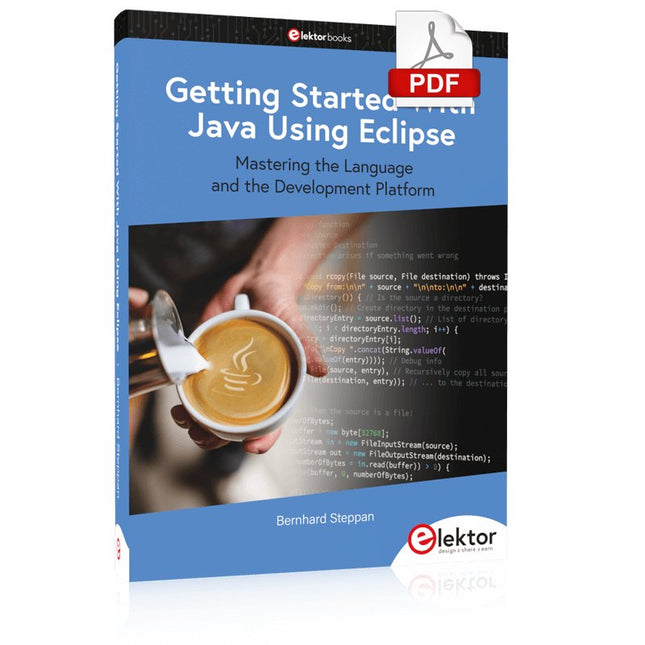
Elektor Digital Getting Started With Java Using Eclipse (E-book)
Maîtriser le langage et la plateforme de développement Beaucoup de gens aimeraient apprendre Java mais se lancer n'est pas facile puisque programmer avec Java nécessite au moins deux choses : maîtriser le langage de programmation et l'environnement de développement. A l'aide de nombreux exemples, ce livre montre comment le langage est structuré. De plus, il utilise l'environnement de développement Eclipse comme exemple d'outil puissant pour enseigner le développement de programmes Java. Dans Basics, la première partie du livre, vous acquérez vos connaissances de base sur Java et Eclipse. Cette partie pose les bases de la programmation, vous donne un aperçu de la technologie Java et vous montre les particularités de la programmation orientée objet. Dans la deuxième partie intitulée Java Language, tout tourne autour des subtilités du langage Java et c'est là que sont créées les premières petites applications Java, aidées par un savant mélange de partie connaissances et d'exercices pratiques. La technologie Java est à la fois le nom et le thème de la troisième partie qui vous présente également les règles à respecter lors de la programmation, ce que sont les bibliothèques de classes et leurs avantages. De plus, vous apprendrez comment tester des programmes, ce que sont les algorithmes et comment les programmer. La quatrième partie, Projets Java, vous permet d'appliquer tous les éléments précédents dans une application avec une interface utilisateur graphique. Le projet montre comment développer une application plus grande pièce par pièce avec l'environnement de développement Eclipse. L'annexe se termine par une section sur les erreurs fréquentes pouvant survenir lors de l'utilisation d'Eclipse et un glossaire.
€ 34,95
Membres € 27,96
-
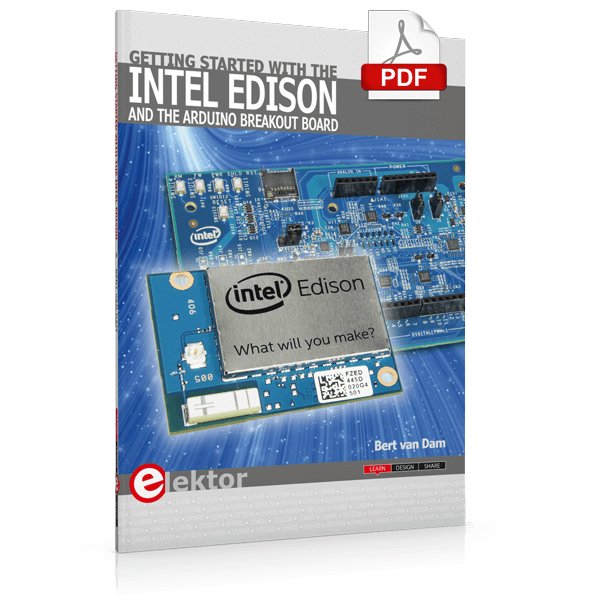
Elektor Digital Getting Started with the Intel Edison (E-book)
The Internet of Things is rapidly gaining interest, and that has fueled the development of the Edison. A tiny computer, the size of a postage stamp, with a lot of power and built-in wireless communication capabilities. In this eBook we will help you get up-to-speed with the Edison, by installing the software both on the Edison as well as on your Windows PC. We will use the Edison Arduino break-out board because it is easy to work with. We will discuss Linux, Arduino C++ and Python, and show examples of how the Edison can interface with other hardware. We will use Wi-Fi and Bluetooth to set up wireless connections, and show you a trick to program sketches over Wi-Fi. Once you have completed this book your Edison will be up and running with the latest software version, and you will have sufficient knowledge of both hardware and software to start making your own applications. You will even be able to program the Edison over USB and wireless both in Arduino C++ and Python. This is not a projects eBook, but a toolbox that will allow you to explore the wonderful world of the Intel Edison!
€ 24,95
Membres € 19,96
-
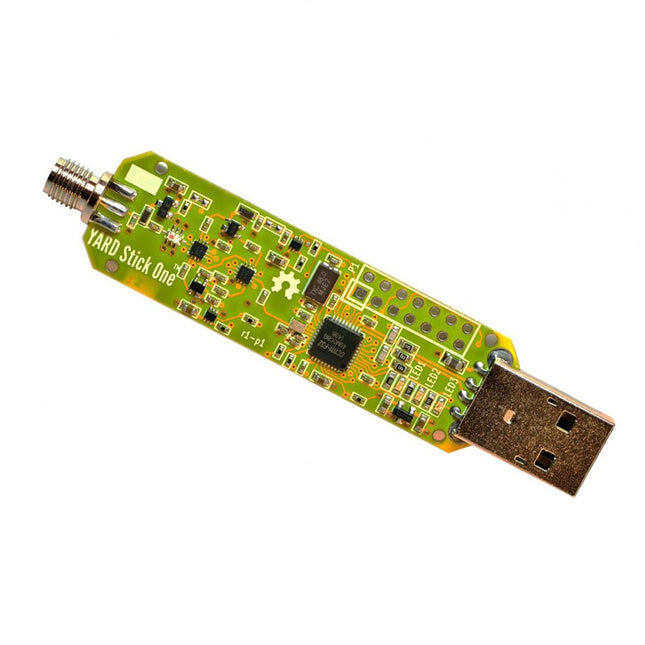
Great Scott Gadgets Great Scott Gadgets YARD Stick One - Outil de test sans fil sub-1 GHz
YARD Stick One (Yet Another Radio Dongle) est un circuit intégré émetteur-récepteur sans fil sub-1 GHz sur un dongle USB. Il est basé sur le Texas Instruments CC1111. YARD Stick One peut émettre ou recevoir des signaux sans fil numériques à des fréquences inférieures à 1 GHz. Il utilise le même circuit radio que le populaire IM-Me. Les fonctions radio qui sont possibles en personnalisant le firmware IM-Me sont maintenant à portée de main lorsque vous connectez YARD Stick One à un ordinateur via USB. Caractéristiques Transmission et réception semi-duplex Fréquences de fonctionnement officielles : 300-348 MHz, 391-464 MHz et 782-928 MHz Fréquences de fonctionnement non officielles : 281-361 MHz, 378-481 MHz et 749-962 MHz Modulations : ASK, OOK, GFSK, 2-FSK, 4-FSK, MSK Débits de données jusqu'à 500 kbps USB 2.0 haute vitesse Connecteur d'antenne femelle SMA (50 ohms) Alimentation du port d'antenne contrôlée par logiciel (max 50 mA à 3,3 V) Filtre passe-bas pour éliminer les harmoniques lors de l'utilisation dans les bandes 800 et 900 MHz En-tête d'expansion et de programmation compatible GoodFET Points de test de programmation compatibles GIMME Open source Téléchargements Documentation GitHub
€ 99,95€ 74,95
Membres identique
-
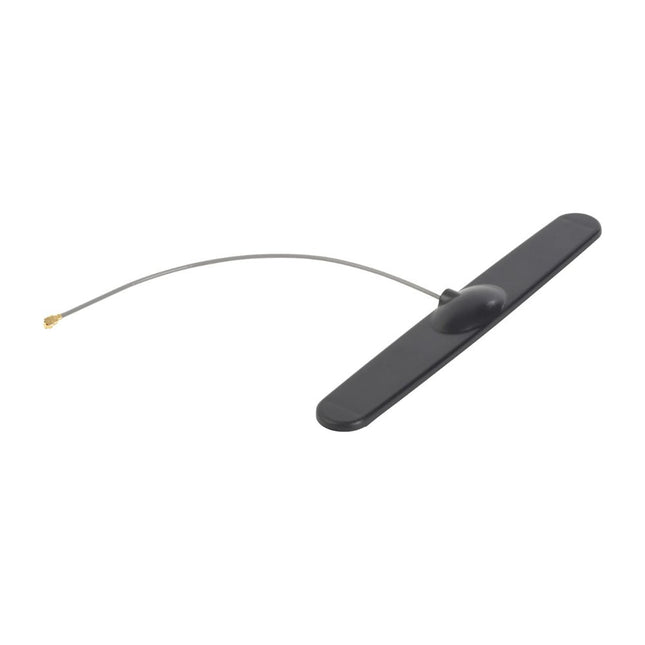
Arduino Antenne GSM pour cartes Arduino MKR
Cette antenne fonctionne également avec Arduino MKR FOX 1200 / Ardunio MKR GSM 1400 / Arduino MKR WAN 1300. Connexion d'antenne : U.FL GSM 433/868/915 MHz
€ 7,95
Membres € 7,16
-

Elektor Digital GSM/GPRS Projects (E-book)
Based on PIC microcontrollers and Arduino Every mobile phone includes a GSM/GPRS modem which enables the phone to communicate with the external world. With the help of the GSM modems, users can establish audio conversations and send and receive SMS text messages. In addition, the GPRS modem enables users to connect to the internet and to send and receive large files such as pictures and video over the internet. This book is aimed for the people who may want to learn how to use the GSM/GPRS modems in microcontroller based projects. Two types of popular microcontroller families are considered in the e-book: PIC microcontrollers, and the Arduino. The highly popular mid-performance PIC18F87J50 microcontroller is used in PIC based projects together with a GSM Click board. In addition, the SIM900 GSM/GPRS shield is used with the Arduino Uno projects. Both GSM and GPRS based projects are included in the e-book. The book will enable you to control equipment remotely by sending SMS messages from your mobile phone to the microcontroller, send the ambient temperature readings from the microcontroller to a mobile phone as SMS messages, use the GPRS commands to access the internet from a microcontroller, send temperature readings to the cloud using UDP and TCP protocols and so on. It is assumed that the reader has some basic working knowledge of the C language and the use of microcontrollers in simple projects. Although not necessary, knowledge of at least one member of the PIC microcontroller family and the Arduino Uno will be an advantage. It will also be useful if the user has some knowledge of basic electronics.
€ 24,95
Membres € 19,96
-
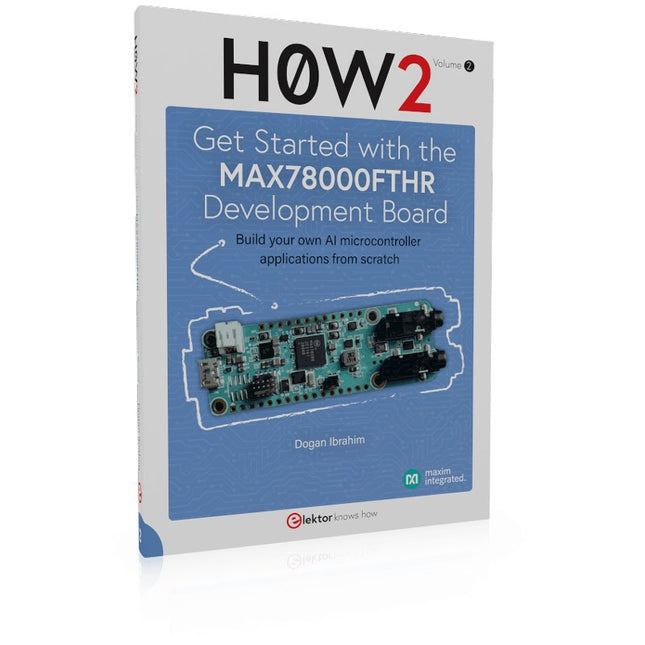
Elektor Publishing H0W2: Get Started with the MAX78000FTHR Development Board
Build your own AI microcontroller applications from scratch The MAX78000FTHR from Maxim Integrated is a small development board based on the MAX78000 MCU. The main usage of this board is in artificial intelligence applications (AI) which generally require large amounts of processing power and memory. It marries an Arm Cortex-M4 processor with a floating-point unit (FPU), convolutional neural network (CNN) accelerator, and RISC-V core into a single device. It is designed for ultra-low power consumption, making it ideal for many portable AI-based applications. This book is project-based and aims to teach the basic features of the MAX78000FTHR. It demonstrates how it can be used in various classical and AI-based projects. Each project is described in detail and complete program listings are provided. Readers should be able to use the projects as they are, or modify them to suit their applications. This book covers the following features of the MAX78000FTHR microcontroller development board: Onboard LEDs and buttons External LEDs and buttons Using analog-to-digital converters I²C projects SPI projects UART projects External interrupts and timer interrupts Using the onboard microphone Using the onboard camera Convolutional Neural Network
€ 39,95
Membres € 35,96























